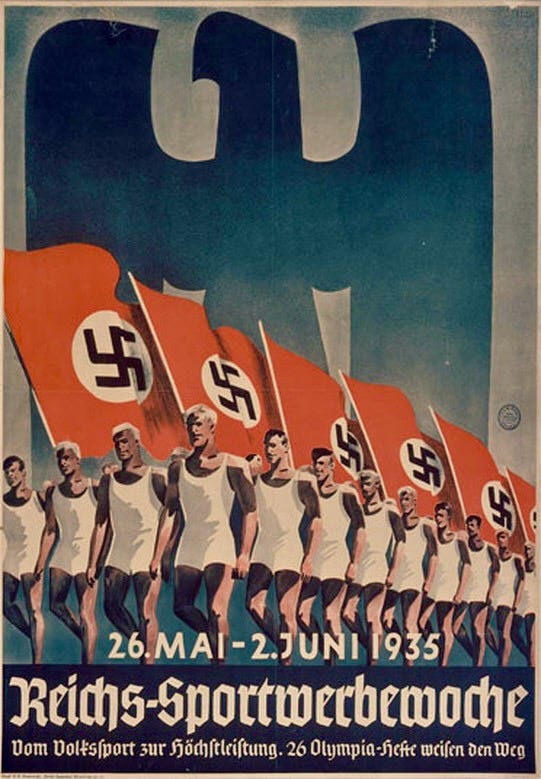Vacation in the Third Reich
How Nazi Germany Used Tourism to Mask Its War Plans and Atrocities

In the annals of history, few artifacts are as baffling as this 1936 map promoting international tourism to Nazi Germany. A country on the brink of launching a devastating war, notorious for its burgeoning totalitarian regime, was simultaneously marketing itself as a picturesque and inviting travel destination.

The map’s design is a masterclass in visual persuasion. Bright, inviting colors depict a serene landscape dotted with historical landmarks, natural beauty, and cultural hotspots. The cities are meticulously illustrated, each a testament to Germany’s rich heritage and architectural splendor. Berlin, Munich, and Hamburg are portrayed as vibrant hubs of activity, promising a blend of modernity and tradition.
But beneath this idyllic portrayal lies a calculated effort to reshape international perception. The travel marketing omits the stark realities of 1936 Germany— the militarization of the Rhineland, the Nuremberg Laws' discriminatory policies, and the pervasive atmosphere of fear and oppression. Instead, it offers an illusion of a nation steeped in culture and peace, beckoning tourists with promises of unforgettable experiences.
Posters like these were marketed globally to attract foreign visitors to Germany. Offices in cities across Europe, North and South America, Africa, and Asia promoted travel to Germany and provided assistance with travel planning.

Technological advances in travel are featured in this poster - Germany’s leading shipping line, the Norddeutscher Lloyd Bremen, connected Germany and the US, bringing thousands of travelers every year. By the end of the 1930s, Deutsche Lufthansa, Germany’s national airline, had established flights all over Europe, to North America, Africa, South America, and the Middle East. In the early years of the Third Reich, only 10% of overnight stays in Germany’s hotels and hostels were booked by Germans, meaning the majority of travelers came from outside of Germany.
Tourism played a strategic role in Nazi Germany’s economic plans. The influx of foreign currency from international tourists was crucial for funding the regime’s expansive military ambitions. In fact, the tourist industry flourished during the Nazi period as people from all over the world visited Germany, especially during the Olympic Games of 1936.
A significant element of Nazi Germany’s international tourism strategy in 1936 was the Berlin Olympics. These games were not merely a sporting event but a meticulously orchestrated propaganda spectacle designed to showcase the supposed superiority and unity of the Aryan race and the Nazi regime’s organizational prowess.
The Olympics provided a global stage for the Nazis to present an image of a peaceful, progressive, and hospitable Germany. The regime went to great lengths to beautify Berlin and build state-of-the-art sports facilities, including the iconic Olympiastadion. They removed anti-Semitic signs and toned down public anti-Jewish rhetoric temporarily to avoid international criticism and boycotts
But personal accounts from foreigners who visited Germany in the late 1930s revealed the omnipresent propaganda and subtle tensions that hinted at the brewing storm.
"The beauty of the Bavarian Alps and the charm of the medieval towns are undeniable. Yet, behind the picturesque façade lies an atmosphere of pervasive fear. The Gestapo's presence is a constant reminder that this serenity is but a thin veil over a harsh reality." ~ John Chancellor in "Germany and the Germans"
Berlin's streets, bustling with tourists and locals alike, exude an air of normalcy. However, scratch the surface, and the signs of a repressive regime are everywhere. The cheerful veneer cannot hide the fact that dissent is brutally crushed and suspicion lurks around every corner." ~ William Shirer in "Berlin Diary"

These artifacts are more than just historical relics; they’re powerful reminders of propaganda’s ability to distort reality. Tourism efforts of Nazi Germany were meticulously crafted to project an image of peace and prosperity. They were part of a larger strategy to win over both domestic and international audiences, while masking the Nazi’s aggressive military ambitions and genocidal plans.
This serves as a cautionary tale about the dangers of propaganda and disinformation, emphasizing the need for vigilance and critical analysis in today’s world, where similar tactics continue to be used to manipulate public perception and obscure the truth.
Here’s two anti-Nazi satires from the era
A Map of Herr Hitler's Heaven (1938)
This 1938 satirical map from Ken Magazine attacks Hitler and the growing threat of Nazi Germany.
The Art of War
“The Map Maker” is a satire attacking the Axis by the artist Arthur Szyk, published in Esquire Magazine in 1942.









So important to remember the lessons from the past that artefacts like these highlight.
Watch what they DO, not what they SAY!
It’s like Where’s Waldo but with swastikas. Impressive artwork though.